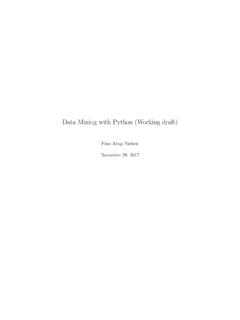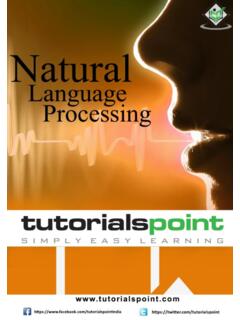Transcription of Text Mining Methodologies with R: An Application to ...
1 Text Mining Methodologies with R: An Application to Central Bank Texts Jonathan Benchimol, Sophia Kazinnik and Yossi Saadon . February 24, 2022. Abstract We review several existing text analysis Methodologies and explain their formal Application processes using the open-source software R and relevant packages. Several text Mining applications to analyze central bank texts are presented. Keywords: Text Mining , R Programming, sentiment analysis , Topic Modelling, Natural Language Processing, Central Bank Communication, Bank of Israel. JEL Codes: B40, C82, C87, D83, E58. This paper does not necessarily reflect the views of the Bank of Israel, the Federal Reserve Bank of Richmond or the Federal Reserve System. The present paper serves as the technical appendix of our research paper (Benchimol et al.)
2 , 2020). We thank Itamar Caspi, Shir Kamenetsky Yadan, Ariel Mansura, Ben Schreiber, and Bar Weinstein for their productive comments. Bank of Israel, Jerusalem, Israel. Corresponding author. Email: Quantitative Supervision and Research, Federal Reserve Bank of Richmond, Charlotte, NC, USA. Email: Research Department, Bank of Israel, Jerusalem, Israel. Email: 1. 1 Introduction The information age is characterized by the rapid growth of data, mostly unstruc- tured data. Unstructured data is often text-heavy, including news articles, social media posts, Twitter feeds, transcribed data from videos, as well as formal docu- The availability of this data presents new opportunities, as well as new challenges, both to researchers and research institutions.
3 In this paper, we review several existing Methodologies for analyzing texts and introduce a formal process of applying text Mining techniques using the open-source software R. In addition, we discuss potential empirical applications. This paper offers a primer on how to systematically extract quantitative infor- mation from unstructured or semi-structured text data. Quantitative representa- tion of text has been widely used in disciplines such as computational linguistics, sociology, communication, political science, and information security. However, there is a growing body of literature in economics that uses this approach to ana- lyze macroeconomic issues, particularly central bank communication and financial The use of this type of text analysis is growing in popularity and has become more widespread with the development of technical tools and packages facilitat- ing information retrieval and An applied approach to text analysis can be described by several sequential steps.
4 Given the unstructured nature of text data, a consistent and repeatable ap- proach is required to assign a set of meaningful quantitative measures to this type of data. This process can be roughly divided into four steps: data selection, data cleaning, information extraction, and analysis of that information. Our tutorial ex- plains each step and shows how it can be executed and implemented using the 1 Usually in Adobe PDF or Microsoft Word formats. 2 See, for instance, Carley (1993), Ehrmann and Fratzscher (2007), Lucca and Trebbi (2009), Bholat et al. (2015), Hansen and McMahon (2016), Bruno (2017), Bholat et al. (2019), Hansen et al. (2019), Calomiris and Mamaysky (2020), Benchimol et al. (2021), Correa et al.
5 (2021), and Ter Ellen et al. (2022). 3 See, for instance, Lexalytics, IBM Watson AlchemyAPI, Provalis Research Text Analytics Soft- ware, SAS Text Miner, Sysomos, Expert System, RapidMiner Text Mining Extension, Clarabridge, Luminoso, Bitext, Etuma, Synapsify, Medallia, Abzooba, General sentiment , Semantria, Kanjoya, Twinword, VisualText, SIFT, Buzzlogix, Averbis, AYLIEN, Brainspace, OdinText, Loop Cognitive Computing Appliance, ai-one, LingPipe, Megaputer, Taste Analytics, LinguaSys, muText, Tex- tualETL, Ascribe, STATISTICA Text Miner, MeaningCloud, Oracle Endeca Information Discovery, Basis Technology, Language Computer, NetOwl, DiscoverText, Angoos KnowledgeREADER, For- est Rim's Textual ETL, Pingar, IBM SPSS Text Analytics, OpenText.
6 Smartlogic, Narrative Science Quill, Google Cloud Natural Language API, TheySay, indico, Microsoft Azure Text Analytics API, Datumbox, Relativity Analytics, Oracle Social Cloud, Thomson Reuters Open Calais, Verint Sys- tems, Intellexer, Rocket Text Analytics, SAP HANA Text Analytics, AUTINDEX, Text2data, Saplo, SYSTRAN, and many others. 2. open-source R software. For our sample data set, we use a set of monthly commu- nications published by the Bank of Israel. In general, an automatic and precise understanding of financial texts allows for the construction of relevant financial indicators. There are many potential applica- tions in economics and finance, as well as other social science disciplines. Central bank publications ( , interest rate announcements, minutes, speeches, official re- ports, etc.)
7 Are of particular interest, considering what a powerful tool central bank communication is. This quick and automatic analysis of the underlying meaning conveyed by these texts should allow for fine-tuning of these publications before making them public. For instance, a spokesperson could use this tool to analyze the orientation of a text, such as an interest rate announcement, before making it public. The remainder of the paper is organized as follows. The next section covers theoretical background behind text analysis and interpretation of text. Section 3. describes text extraction and Section 4 presents Methodologies for cleaning and storing text data for text Mining . Section 5 presents several common approaches to text data structures used in Section 6, which details Methodologies used for text analysis , and Section 7 concludes.
8 2 Theoretical Background The principal goal of text analysis is to capture and analyze all possible meanings embedded in the text. This can be done both qualitatively and quantitatively. The purpose of this paper is to offer an accessible tutorial to the quantitative approach. In general, quantitative text analysis is a field of research that studies the ability to decode data from natural language with computational tools. Quantitative text analysis takes roots in a set of simple computational methods, focused on quantifying the presence of certain keywords or concepts with a text. These methods, however, fail to take into account the underlying meaning of text. This is problematic because, as shown by Carley (1993), two identical sets of words can have very different meanings.
9 This realization and subsequent need to capture meaning embedded in text gave rise to the development of new methods, such as language network models, and, specifically, semantic networks (Danowski, 1993;. Diesner, 2013). Today, the common approach in quantitative text Mining is to find relationships between concepts, generating what is known as a semantic network. Semantic network analysis is characterized by its ability to illustrate the rela- tionships between words within a text, providing insights into its structure and 3. meaning. Semantic networks rely on co-occurrence metrics to represent proxim- ity concepts (Diesner and Carley, 2011a,b; Diesner, 2013). For instance, nodes in a network represent concepts or themes that frequently co-occur near each other in a specific text.
10 As a result, semantic network analysis allows meaning to be revealed by considering the relationships among concepts. In this paper, we cover both of the approaches mentioned above. We first discuss term-counting methods, such as term frequency and relative frequency calculations. We follow with networks-based methods, such as cluster analysis , topic modeling, and latent semantic analysis . Overall, the field of natural lan- guage processing (NLP) has progressed rapidly in recent years, but these methods still remain to be essential and relevant building blocks of quantitative language analysis . The next three sections present a comprehensive set of steps for text analysis , starting with common Methodologies for cleaning and storing text, as well as dis- cussing several common approaches to text data structures.













